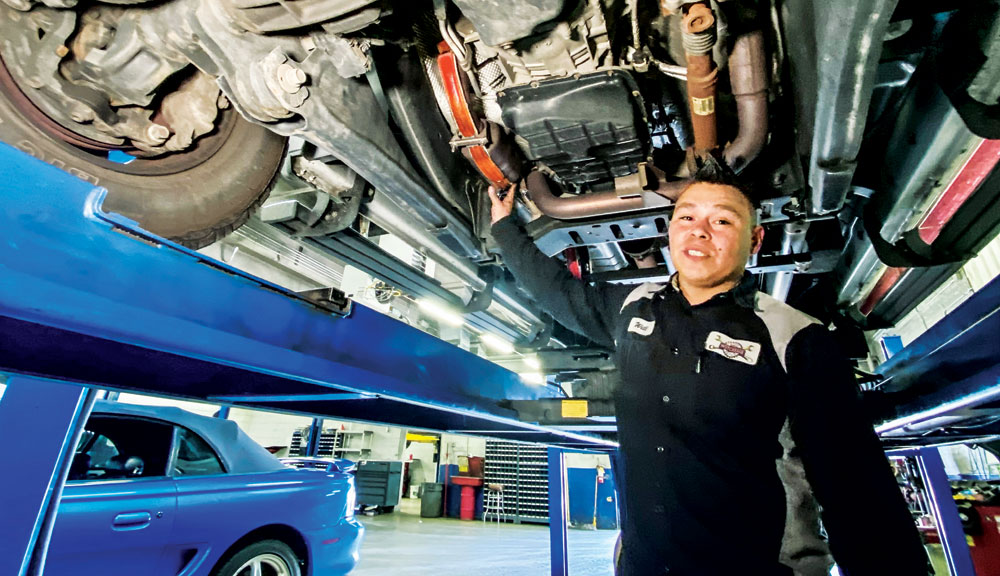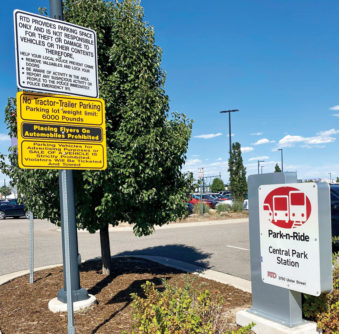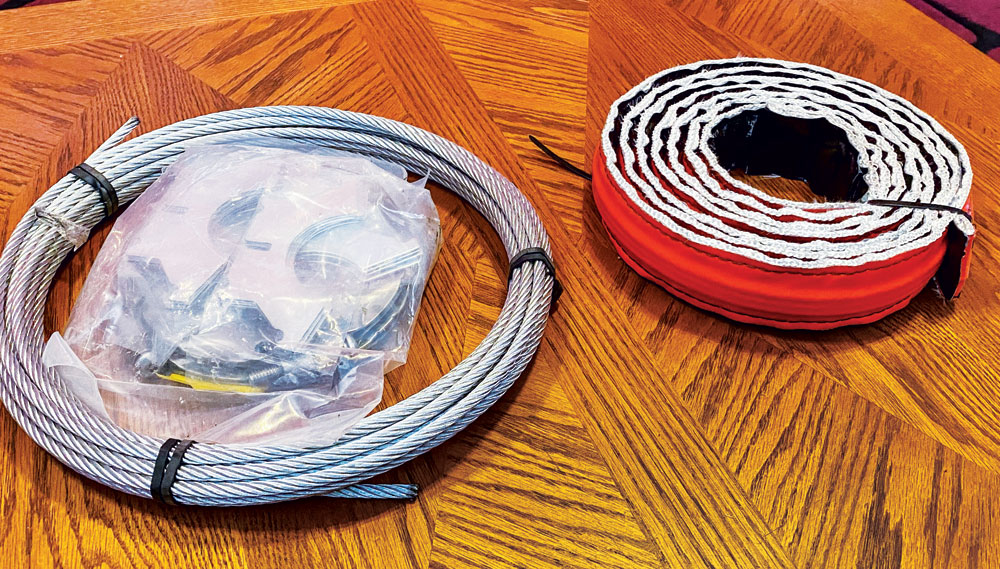
Technician Will Calderon, from Hotchkiss Auto Repair in Northeast Denver, explains how a catalytic converter safety device is installed. In the past year, the shop has installed approximately 130 devices due to the recent surge of catalytic converter thefts in the city. Stolen catalytic converters can cost $1,200-$6,000 to replace.
Over the past three years, the rates of car crimes committed in Denver have skyrocketed and include vandalism, catalytic converter removal, gasoline siphoning, and vehicle theft. Although these problems are impacting the entire city, car crimes have been especially prevalent in Northeast Denver neighborhoods.
FBI data compiled by the Common Sense Institute, a non-partisan research group, demonstrates that Colorado has the highest per capita car theft rates in the nation and that Denver has the second highest rates of any city (just behind Bakersville, California). The auto theft rates in Denver have been rising substantially since 2019, and Denver Police Department data shows that the rates have increased by another 80-percent in 2022.
This issue has hit Northeast Denver especially hard. Already in 2022, car theft has risen in Northeast Park Hill by 86 percent, in the East Colfax neighborhood by 87 percent, in Lowry by 136 percent, and Central Park by 157 percent. Central Park, in fact, has the second highest spike of car thefts in the city, with the only higher rate being in the nearby community of Skyland.

At a community meeting at the Montbello Recreation Center, the District 5 police unit speaks to Northeast Denver residents about the crime rates. The police panel included officers, lieutenants, detectives, and commanders. The meeting featured a presentation by the police about crime data for NE Denver followed by comments from residents who are concerned about the safety of their communities.
“I know that there are a lot of car thefts in Central Park,” says Denver District Attorney Beth McCann. “Maybe it’s because the kind of cars that people drive in Central Park are more desirable, maybe it’s where they park them, or maybe it’s just easier to get out of the neighborhood quickly.”
The many auto theft rings operating in Denver have been the primary targets of DA prosecutors. “Since 2019, we’ve been jumping up every year by at least 200 cases that we’re filing against motor vehicle theft,” explains McCann. “We’re devoting a lot of those resources on the complex cases that we can take into the Grand Jury. We’ve been focusing on the bigger fish of organized rings that are making this their career, stealing lots of cars, and preying on people with automobile crimes.”
This past May, the DA’s Office achieved a significant victory by indicting an 11-person car theft ring that used electronic devices to steal over 100 cars worth more than $3 million. “The indictment of that ring was a big deal,” says McCann. “We took several people out of commission, removed a number of people from the community who were active in the car theft world, and we’re hoping that the indictment deters others from following in their tracks and from committing those crimes.”
McCann also hopes that the increased prosecutions of car thieves can reduce the rates in Northeast Denver. “We take the car theft issues in Northeast Denver very seriously. When we have enough evidence to prove a case we will always file it, so I encourage people to report any incidents in their communities and we will always do our best to prosecute the cases.”

Cale Gould, Colorado Auto Theft Prevention Authority.
Photo courtesy of Cale Gould
The problem of catalytic converters being stolen from cars is another type of crime that has become frequent throughout Denver and prevalent in northeast neighborhoods. Catalytic converters transform toxic pollutants from the vehicles into safer chemicals for the air. But these parts also contain rare metals, and so thieves have become adept at sliding under cars, cutting out the converters, and leaving the scenes within minutes.
The Colorado Auto Theft Prevention Authority (CATPA) has been a leader in combating this new problem of catalytic converter theft. CATPA allocates funds, develops programs, and promotes legislation to reduce all types of auto crimes. CATPA also funds the Colorado Metropolitan Auto Theft Task Force (C-MATT), which specializes in apprehending car thieves throughout Denver and its surrounding suburbs. With the rates of converter theft rising by over 5,000 percent since 2019, CATPA is allocating more resources towards alleviating this crime.
“Catalytic converter theft really took off in the pandemic era,” says Cale Gould, the Program Assistant of CATPA. “The precious metals that are in the converters were no longer being produced at the same rates during the pandemic, and so the price of these metals skyrocketed. A converter that you could recycle for just $50 suddenly rose in value and became worth $200 to $500.”

The Central Park RTD lot has among the highest rates of car crimes in Denver. Thieves have been targeting this hotspot to steal cars, converters, and gas.
The lack of identifying markers on the converters makes it difficult for police officers to retrieve the parts or catch the criminals. “Our public outreach program for catalytic converters includes a huge identification element,” says Gould. “We’re trying to adopt an identification labeling system for catalytic converters that was successful for the United Kingdom. We’re hoping that changing legislation and working with the automotive industry can lead to big changes of new car models having these identifiable labels on the converters.”
The Park-n-Ride at the Central Park RTD station has been one of the biggest hotspots for catalytic converter theft. Besides DIA, the Central Park RTD lot has the highest number of catalytic converter thefts of any location in the city. The Central Park lot has also been susceptible for other auto-related crimes. It is one of the worst locations in the city for stolen vehicles, and it is the primary spot where criminals have been stealing gas by puncturing the tanks under the cars and pouring the fuel into cannisters.
“RTD Transit Police is dedicating a police officer to check problematic lots that have experienced theft from vehicles or stolen vehicles,” says RTD Communications Manager Marta Sipeki in a statement to Front Porch. “The agency’s police department continues to collaborate with the Denver Police Department about trouble spots. RTD encourages the public to download its free Transit Watch app to directly communicate with RTD Police Dispatch if they see suspicious behavior or activity.”
A recent community meeting gave Northeast residents a chance to express their concerns with the Denver Police Department. The meeting was held on Sept 1 at the Montbello Recreation Center, and the DPD panel included many officers and detectives from the District 5 unit that encompasses Northeast Denver. The panel was also joined by Denver Police Chief Ron Thomas, who had been nominated to the position the previous day.

DPD Chief Ron Thomas speaks at the Montbello meeting. Thomas, a former District 5 Commander, was nominated as Chief on Aug 30.
During the discussion, residents articulated their dissatisfaction with the inadequate response by police as crime rates keep rising in their neighborhoods. Some attendees believed the officers should be more present on the streets and responsive to the crimes. The need for the police to improve their relationships with the residents was a consistent theme throughout the meeting, and many people argued that the officers should foster better connections to the communities.
“We want you to come to our level, and we want to know how you feel about the crime and what you think you can do about the crime,” said NE Denver resident Larry Murray. “They’re producing guns and none of you guys have been stopping the guns from coming into our community. And when issues are going on I’ll look around for the police but I never see them, so if you get police into the major areas of the community that would stop a lot of these crimes.”
The police officers were generally receptive to these complaints. Some officers agreed that the rising crime rates in the neighborhoods warranted improved performances from the department, and many officers emphasized the importance of developing positive relationships with the residents. DPD also encouraged the residents to always report these issues. The officers emphasized that engaging with the community and collaborating with the residents can help them more effectively patrol the hotspots, deter those crimes, and protect Denver’s neighborhoods.
Preventing Catalytic Converter Theft
The increased frequency of catalytic converter theft throughout Denver has encouraged many car owners to purchase protection devices that can restrict thieves from stealing the parts. It can help to know the different types of protection devices that are available and the particular features of each option.

Two variations of catalytic converter safety systems that Hotchkiss Auto Repair in Northeast Denver uses.
Cat-Clamp: Many auto shops sell and install universal cat-clamp devices that can fit onto most cars. The cat-clamp is a cage that wraps around the catalytic converter, locks it in place, and obstructs access to the converter. Although determined thieves can still cut through the cat-clamp to reach the converter, the process of doing so is arduous and time-consuming. Since the appeal of catalytic converter theft is the fast process of the crime, adding this extra layer of difficulty can serve as an effective deterrent against theft.
Cat-Shields: This is another safety device that can protect your catalytic converters. The cat-shields are flat metal plates that are installed on the car beneath the converter. The metal is usually hard enough to prevent thieves from being able to cut through the plate, making it a reliable option to secure your converter and repel the thieves. However, the shields are not universal and so you would need a particular plate that is compatible for your car. Many cat-shield companies design products for different types of cars, and some dealerships provide cat-shields that are customized to fit their models.
Converter Alarms: Alarm devices can also protect your catalytic converter. The devices are fastened to the bottom of the car, and the motion sensors can sound the alarm when the converter is moved. The alarms are generally inexpensive, easy to install, and universal for most types of cars. The detriment is that the alarm does not lock the converter in place and so thieves can still take the part. But the sound of the alarm could be sufficient to scare away criminals, and the sight of the device could prevent them from targeting your car.
Front Porch photos by Christie Gosch


Had my Ford F150 stolen from the Sleep Inn parking lot on Tower Rd on 1/4/25. Denver took my report over the phone but refuse to get the hotel’s video, put my vehicle on the active MICI list, or even call me back. I am from Kansas and people should be warned about traveling to Denver ! Very disappointed in the Denver PD